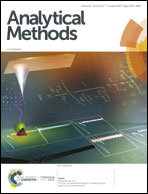Photoelectrochemical-assisted determination of caffeic acid exploiting a composite based on carbon nanotubes, cadmium telluride quantum dots, and titanium dioxide†
Abstract
Caffeic acid (CA) is an important phenolic compound of natural occurrence with antioxidant and anti-inflammatory activities as well as antimicrobial and cytotoxic properties that are of high importance for the human organism. Thus, the present work reports the development of a novel photoelectrochemical (PEC) sensor for CA determination based on titanium dioxide nanoparticles (TiO2), carbon nanotubes (CNTs), and cadmium telluride quantum dots (CdTeQDs) which form the TiO2/CNTs/CdTeQDs/FTO PEC sensor. The PEC sensor exhibited a high photocurrent in the presence of CA under the incidence of visible LED light when compared to each material used in the construction of the composite material. Characterization of the materials was performed by X-ray diffraction (XRD), scanning electron microscopy (SEM), linear scanning voltammetry (LSV), electrochemical impedance spectroscopy (EIS) and amperometry. Under optimized experimental and operational conditions, the photocurrent of the PEC sensor exhibited a linear relationship with the increase of CA concentration from 0.5 to 360 μmol L−1 and a detection limit of 0.15 μmol L−1. By using the standard addition method, the sensor was successfully applied for the determination of CA in samples of tea and soluble coffee. The PEC sensor presented average recovery values for CA in coffee and tea samples of 99.9% and 97.4%, respectively, suggesting good accuracy of the proposed method. In addition, the sensor demonstrated excellent precision, selectivity, and reproducibility for the determination of CA.



 Please wait while we load your content...
Please wait while we load your content...